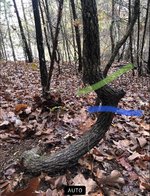SmallTreeGuy
Yamadori
Hello, all!
On Thanksgiving day at my parents’ place we went for a walk through their woods and I saw this curved elm amidst the forest of straight trunks. I love the sweeping curve so I am considering it for collection.
Now onto the questions lol. Should I root prune some and wait a couple of seasons to collect? Someone gave me this advice and I was wanting to see if that’s recommended here by any of you more experienced at bonsai or yamadori collection. It was also suggested that I do the trunk chop in the woods and let it grow out a season before collecting as well.
Can anyone see the reason to do either of these things? I was planning to collect right at the end of winter right before bud break. The canopy in the woods gets rather thick in the summer so I don’t know that it would get enough sunlight to leave it in the woods after a chop. I’m definitely willing to do these things if it would be better practice for the sake of the tree’s health.
I have all the tools necessary to do the dig and I’m going to go ahead and assume there is a quite large tap root, so I know collection might not be easy, but I definitely want to do the right prep work if any is needed to make it a successful collection.
Picture of the Elm is shown below and two possible trunk chip options shown in the other. Thanks in advance, everyone!
On Thanksgiving day at my parents’ place we went for a walk through their woods and I saw this curved elm amidst the forest of straight trunks. I love the sweeping curve so I am considering it for collection.
Now onto the questions lol. Should I root prune some and wait a couple of seasons to collect? Someone gave me this advice and I was wanting to see if that’s recommended here by any of you more experienced at bonsai or yamadori collection. It was also suggested that I do the trunk chop in the woods and let it grow out a season before collecting as well.
Can anyone see the reason to do either of these things? I was planning to collect right at the end of winter right before bud break. The canopy in the woods gets rather thick in the summer so I don’t know that it would get enough sunlight to leave it in the woods after a chop. I’m definitely willing to do these things if it would be better practice for the sake of the tree’s health.
I have all the tools necessary to do the dig and I’m going to go ahead and assume there is a quite large tap root, so I know collection might not be easy, but I definitely want to do the right prep work if any is needed to make it a successful collection.
Picture of the Elm is shown below and two possible trunk chip options shown in the other. Thanks in advance, everyone!


